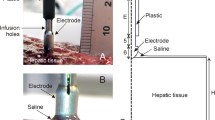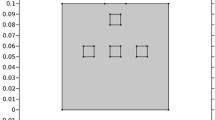Abstract
The current study evaluates radiofrequency (RF) ablation of hepatic tumors with an expandable multi-prong RF applicator. To assess the localized cooling effect of blood flow on necrosis volume, a three-dimensional computational model of hepatic tissue, cancer tumor, blood vessel, and RF applicator was created. The finite element method is used to calculate the effect of blood vessel location, diameter, change in input voltage, and tumor property uncertainty on ablation volume. An increase in blood vessel diameter causes a 6.52% reduction in ablation volume, and a 10 mm diameter blood vessel located next to a tumor causes a 12.19% reduction in ablation volume.
Access this chapter
Tax calculation will be finalised at checkout
Purchases are for personal use only
Similar content being viewed by others

References
White DL, Thrift AP, Kanwal F, Davila J, El-Serag HB (2017) Incidence of hepatocellular carcinoma in all 50 United States, from 2000 through 2012. Gastroenterology 152
Yamao T, Imai K, Yamashita Y-I, Kaida T, Nakagawa S, Mima K, Hashimoto D, Chikamoto A, Ishiko T, Baba H (2018) Surgical treatment strategy for hepatocellular carcinoma in patients with impaired liver function: hepatic resection or radiofrequency ablation? HPB 20
Chen ZP, Roemer RB (1992) The effects of large blood vessels on temperature distributions during simulated hyperthermia. J Biomech Eng 114
Kolios MC, Sherar MD, Hunt JW (1995) Large blood vessel cooling in heated tissues: a numerical study. Phys Med Biol 40
Chinn SB, Lee FT, Kennedy GD, Chinn C, Johnson CD, Winter TC, Warner TF, Mahvi MD (2001) Effect of vascular occlusion on radiofrequency ablation of the liver: Results in a porcine model. Am J Roentgenol 176
Jain MK, Wolf PD (2001) A three-dimensional finite element model of radiofrequency ablation with blood flow and its experimental validation. Ann Biomed Eng 28
Tungjitkusolmun S, Staelin TS, Haemmerich D, Tsai J-Z, Webster J, Lee FT, Mahvi MD, Vorperian VR (2002) Three-dimensional finite-element analyses for radio-frequency hepatic tumor ablation. IEEE Trans Bio-Med Eng 49
Haemmerich D, Tungjitkusolmun S, Staelin TS, Lee FT, Mahvi DM, Webster J (2002) Finite-element analysis of hepatic multiple probe radio-frequency ablation. IEEE Trans Bio-Med Eng 49
González-Suárez A., Trujillo M, Burdío F, Andaluz A, Berjano E (2014) Could the heat sink effect of blood flow inside large vessels protect the vessel wall from thermal damage during RF-assisted surgical resection? Med Phys 41
Huang H-W (2013) Influence of blood vessel on the thermal lesion formation during radiofrequency ablation for liver tumors. Med Phys 40
Haemmerich D, Staelin ST, Tsai JZ, Tungjitkusolmun S, Mahvi DM, Webster JG (2003) In vivo electrical conductivity of hepatic tumours. Physiol Meas 251
Liu Z, Ahmed M, Sabir A, Humphries S, Goldberg SN (2007) Computer modeling of the effect of perfusion on heating patterns in radiofrequency tumor ablation. Int J Hypertherm 23(1)
Schutt DJ, Haemmerich D (2008) Effects of variation in perfusion rates and of perfusion models in computational models of radio frequency tumor ablation. Med Phys 35
Hall SK, Ooi EH, Payne SJ (2015) Cell death, perfusion and electrical parameters are critical in models of hepatic radiofrequency ablation. Int J Hypertherm 31
Haemmerich D, Chachati L, Wright AS, Mahvi DM, Lee FT, Webster J (2007) Hepatic radiofrequency ablation with internally cooled probes: Effect of coolant temperature on lesion size. IEEE Trans Bio-Med Eng 50
Takaki H, Nakatsuka A, Uraki J, Yamanaka T, Fujimori M, Hasegawa T, Arima K, Sugimura Y, Yamakado K (2013) Renal cell carcinoma: radiofrequency ablation with a multiple-electrode switching system—a phase II clinical study. Radiology 267
Zhang B, Moser M, Zhang E, Luo Y, Zhang H, Zhang W (2014) Study of the relationship between the target tissue necrosis volume and the target tissue size in liver tumours using two-compartment finite element RFA modelling. Int J Hypertherm 30
Shao YL, Leo HL, Chua KJ (2017) Studying the thermal performance of a bipolar radiofrequency ablation with an improved electrode matrix system: in vitro experiments and modelling. Appl Therm Eng 116
Sheu TW, Chou CW, Tsai SF, Liang PC (2005) Three-dimensional analysis for radiofrequency ablation of liver tumor with blood perfusion effect. Comp Methods Biomech Biomed Eng 8(4)
Tsushima Y, Funabasama S, Aoki J, Sanada S, Endo K (2004) Quantitative perfusion map of malignant liver tumors, created from dynamic computed tomography data 1. Acad Radiol 11(2)
Shao YL, Arjun B, Leo HL, Chua KJ (2017) A computational theoretical model for radiofrequency ablation of tumor with complex vascularization. Comput Biol Med 1:89
Author information
Authors and Affiliations
Corresponding author
Editor information
Editors and Affiliations
Rights and permissions
Copyright information
© 2023 The Author(s), under exclusive license to Springer Nature Singapore Pte Ltd.
About this chapter
Cite this chapter
Sadikbasha, S., Deoghare, A.B. (2023). In-silico Analysis of Expandable Radiofrequency Electrode for Ablation of Hepatic Tumors. In: Guha, K., Dutta, G., Biswas, A., Srinivasa Rao, K. (eds) MEMS and Microfluidics in Healthcare. Lecture Notes in Electrical Engineering, vol 989. Springer, Singapore. https://doi.org/10.1007/978-981-19-8714-4_7
Download citation
DOI: https://doi.org/10.1007/978-981-19-8714-4_7
Published:
Publisher Name: Springer, Singapore
Print ISBN: 978-981-19-8713-7
Online ISBN: 978-981-19-8714-4
eBook Packages: Biomedical and Life SciencesBiomedical and Life Sciences (R0)



